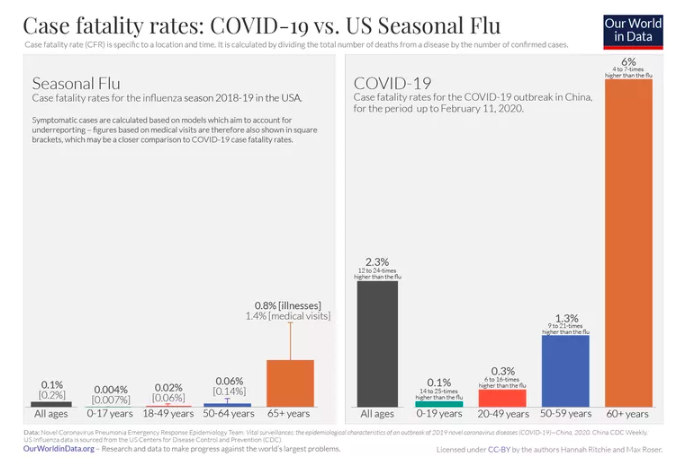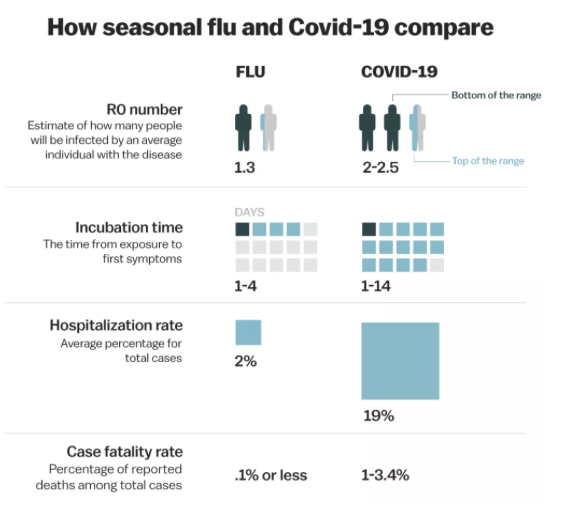Why Comparing the Coronavirus to the Flu is Misleading

October 13, 2020
We seem to hear that Covid-19 is just like the flu, whether it be on news stations or even from our family and friends. While this accusation might seem true considering the similar symptoms, there is an array of statistics that prove otherwise ranging from the contagiousness to the number of deaths per year. By believing that they are the same, we can be relieved from the mental and economical struggles faced. Frankly, Covid-19 is not like the flu. It’s worse.
Based on the CDC’s (Centers for Disease Control and Prevention) website, most of their symptoms are the same, while there are only two symptoms that solely belong to Covid-19 which are shortness of breath and loss of taste and smell. This means that without a test, it is very difficult to tell what is going on in your body. Not only is it difficult to see what’s wrong once you get symptoms, you don’t show them for a couple of days. This time between when you get infected and when symptoms appear is known as the incubation period. The flu has an incubation period of around two days. You get infected and then you feel sick the next day. As for Covid-19, the incubation period is “on average 5-6 days, however, can be up to 14 days” according to the World Health Organization (WHO). The incubation period is the most dangerous time since those infected can spread the virus without even knowing they have it. On top of that, there are asymptomatic cases where people have Covid-19 but don’t reveal any symptoms, thus allowing the virus to spread like wildfire.
In order to see how contagious this virus is, we must look at their basic reproduction numbers (also known as r-naught or R0). The R0 of a virus tells the average number of people that an infected person infects. For example, measles, one of the most contagious diseases, has an R0 of 12-18. Thus, someone with measles infects an average of 12-18 people. As for the flu, it has an R0 of just 1.3 and the coronavirus has an R0 of 2-2.5 people. Although the difference between their R0 doesn’t seem that big, especially when you compare it to measles, it is a huge difference.

If you were to have a simulation where someone with the flu starts a chain of infection based on its R0, after 10 rounds of infections, 56 people would have the flu. If you were to do that same simulation but with Covid-19’s R0, then after 10 rounds, over 2,000 people would be infected with Covid. With the ongoing struggle to control this virus, scientists have said that between 20-60% of the global population may be infected by the end of this pandemic.
The rapid spread of the virus has caused 60,000 new cases each day, which over the past couple of months has accumulated over 35 million cases of Covid-19 worldwide. Out of all these cases, 20-31% of those infected need to go to the hospital, whereas for the flu, only 2% do. That difference in hospitalization rate displays how many millions of people are at extreme risk of the coronavirus over the flu. With the flu’s low hospitalization rate, there are “between 12,000-61,000 deaths annually” (CDC). Compared to Covid-19’s 210,000+ deaths so far, the number of annual deaths per year from the flu is drastically lower. An important thing to mention is that we haven’t even had the coronavirus for an entire year yet. Back in 2019, none of us have ever heard of the virus, thus meaning that we have 4 times the number of deaths as the flu annually and we have only known of its existence for 8 months. These 210,000+ deaths only account for 1-3% of those infected, meaning that the mortality of it is 1-3%. According to Dr. Anthony Fauci, the flu “has a mortality of 0.1%, [while the coronavirus] has a mortality of 10 times that”. A 0.1% mortality rate is extremely lower than a 1-3% mortality rate. Moreover, morality is much higher among older age groups, making it even more dangerous for some.
Although older age groups are more vulnerable to the flu too, there are many forms of immunity to it. Each year, millions of people get their flu shots to become immune, whether it’s at their doctors or at their school like here in Radnor. For other people, they may have flu strains in their bodies so they’re already immune. Since most people have some form of immunity, those who may not be able to receive a vaccine are protected from the flu because of a system called herd immunity. In herd immunity, so many people are immune to the infection that it has trouble creating a chain of infection, thus creating a shield for many vulnerable populations. As for Covid-19, it is brand new to everyone so we’re all at risk of contracting the virus. Since we also don’t have any vaccinations, the best way to fight against the spread of the coronavirus is by keeping safe measures.
The most effective type of precaution is quarantining. This makes it practically impossible for the virus to enter your household because there isn’t a physical connection between you and those infected. Obviously, most people can’t completely isolate themselves from the outside world whether you are going to school or to get food. If you’re around people, make sure that you social distance, wear a mask, and frequently wash your hands. All these methods help to prevent infection by either shielding from passing the infection on or killing the virus if it’s on you. By doing them all, you will have a low chance of contracting Covid-19.
While it’s understandable to believe that the two viruses are the same considering their symptoms, other statistics prove otherwise. Covid-19’s contagiousness, hospitalization rate, and morality are all much higher than the flu, making it much more threatening. And since the virus is new to humans, we’re all susceptible to it. So, make sure that you do your part in staying safe by quarantining, social distancing, wearing a mask, and washing your hands to take yourself out of the chain of infection.








